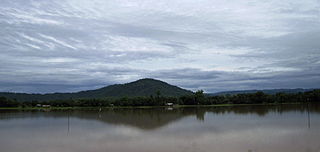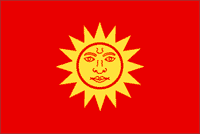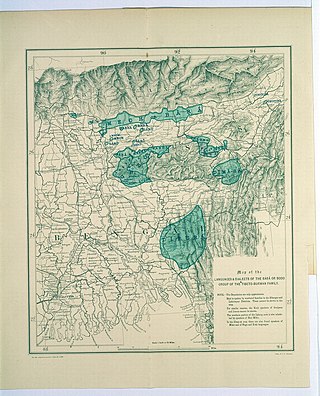Related Research Articles

Boro, also called Bodo, is an ethnolinguistic group native to the state of Assam in India. They are a part of the greater Bodo-Kachari family of ethnolinguistic groups and are spread across northeastern India. They are concentrated mainly in the Bodoland Territorial Region of Assam, though Boros inhabit all other districts of Assam and Meghalaya.

Diphu is the headquarter of Karbi Anglong district in the state of Assam in India. This small town is a popular tourist hill station for people of nearby cities.

The Koch dynasty ruled parts of eastern Indian subcontinent in present-day Assam and Bengal. Biswa Singha established power in the erstwhile Kamata Kingdom which had emerged from the decaying Kamarupa Kingdom. The dynasty came to power by removing the Baro-Bhuyans, who had earlier removed the short-lived rule established by Alauddin Hussain Shah.

The Dimasa people are an ethnolinguistic community presently inhabiting in Assam and Nagaland states in Northeastern India. They speak Dimasa, a Tibeto-Burman language. This community is fairly homogeneous and exclusive, with members required to draw from both parents' separate clans. Dimasa kingdom, one of many early states in Assam following the downfall of Kamarupa kingdom, was established by these people. The Dimasas were till recently agricultural, centering on shifting agriculture; but in recent times this has changed with profound changes in the community. Following political problems in the 18th century, the Dimasa ruler moved further south in the plains of Cachar and there took place a division among them–with the hills Dimasa maintaining their traditional living and political exclusiveness, the plains Dimasas have made no attempt to assert themselves.

Bodo–Kacharis is a name used by anthropologist and linguists to define a collection of ethnic groups living predominantly in the Northeast Indian states of Assam, Tripura, and Meghalaya. These peoples are speakers of either Bodo–Garo languages or Assamese. Some Tibeto-Burman speakers who live closely in and around the Brahmaputra valley, such as the Mising people and Karbi people, are not considered Bodo–Kachari. Many of these peoples have formed early states in the late Medieval era of Indian history and came under varying degrees of Sanskritisation.

The People of Assam inhabit a multi-ethnic, multi-linguistic and multi-religious society. They speak languages that belong to four main language groups: Tibeto-Burman, Indo-Aryan, Tai-Kadai, and Austroasiatic. The large number of ethnic and linguistic groups, the population composition, and the peopling process in the state has led to it being called an "India in miniature".

Kachari is a Sino-Tibetan language of the Boro-Garo branch that is spoken in Assam, India. With fewer than 60,000 speakers recorded in 1997, and the Asam 2001 Census reporting a literacy rate of 81% the Kachari language is currently ranked as threatened. Kachari is closely related to surrounding languages, including Tiwa, Rābhā, Hajong, Kochi and Mechi.
The Assamese people are a socio-ethnic linguistic identity that has been described at various times as nationalistic or micro-nationalistic. This group is often associated with the Assamese language, the easternmost Indo-Aryan language, and Assamese people mostly live in the Brahmaputra Valley region of Assam, where they are native and constitute around 56% of the Valley's population. The use of the term precedes the name of the language or the people. It has also been used retrospectively to the people of Assam before the term "Assamese" came into use. They are an ethnically diverse group formed after centuries of assimilation of Austroasiatic, Tibeto-Burman, Indo-Aryan and Tai populations, and constitute a tribal-caste continuum—though not all Assamese people are Hindus and ethnic Assamese Muslims numbering around 42 lakh (4,200,000) constitute a significant part of this identity. The total population of Assamese speakers in Assam is nearly 15.09 million which makes up 48.38% of the population of state according to the Language census of 2011.
The Boro–Garo languages are a branch of Sino-Tibetan languages, spoken primarily in Northeast India and parts of Bangladesh.

The Mech is an ethnic group belonging to the Bodo-Kachari group of peoples. It is one of the scheduled tribes of India, listed both in West Bengal and Assam, India. They inhabit West Bengal, Nepal, Assam and Nagaland.

Kalita is an ethnic group or a caste of Assamese Hindus belonging to the state of Assam in North East India. Kalita is a forward caste and belongs to General or Unreserved category. Kalita represents a category in the tribe-caste continuum of Assamese society that is placed between the Keot on one side and Ganak and Brahmin on the other. According to historians like S.L.Barua, Kalitas started migrating from North and East India to Assam during the 11th century rule of Dharmapal.

The Tiwa people, are a Tibeto-Burmese ethnic group primarily inhabiting the Northeast Indian states of Assam, Meghalaya, Arunachal Pradesh, Manipur and Nagaland, and some parts of neighbouring Bangladesh and Myanmar.

The Koch are a small trans-border ethnic group of Assam and Meghalaya in India and northern Bangladesh. The group consists of nine matrilineal and strictly exogamous clans, with some of them preserving a hitherto sparsely documented Boro-Garo language called Koch, whereas others have switched to local varieties of Indo-Aryan languages. It is a Scheduled Tribe in Meghalaya, India. Koches want to preserve language and culture and heritage.

The Hajong people are an ethnic group from Northeast India and northern parts of Bangladesh. The majority of the Hajongs are settled in India and are predominantly rice-farmers. They are said to have brought wet-field cultivation to Garo Hills, where the Garo people used slash and burn method of agriculture. Hajong have the status of a Scheduled Tribe in India and they are the fourth largest tribal ethnicity in the Indian state of Meghalaya.
The Sarania Kachari is an ethnic community in the state of Assam, Northeast India. Members of this community are mostly found in the districts of Kamrup (Metro), Kamrup (Rural), Nalbari, Baksa, Udalguri, Darrang, Barpeta, Dhemaji and Bongaigoan. Sarania is a category in the tribe-caste continuum of Assamese society. This category is also known as Phairi in the Nowgong district of Assam. In this category, a tribal neophyte starts giving up on habits such as the drinking of liquor. Scholars have identified an instance of this process taking place in Boroma area in the erstwhile Nalbari district in the late 19th century, where a section of Boro population were assimilated into the Assamese society. The notable surnames used by the community are Sarania, Das, Deka, Choudhury, Medhi, Hazarika etc.
The Constitution of India categorizes the tribes of Assam into two groups: Scheduled Tribes (Hills) and Scheduled Tribes (Plains). Since hills tribes living in the plains and plains tribes living in the hills in large numbers are not recognised as scheduled tribes in the respective places, the census data may not reflect the correct figures. Assamese language is used as the lingua franca by almost all the tribes. According to the 2001 census, Scheduled Tribes made up 12.4 percent of Assam's population. The Assam Tribune reported in 2009 that the tribal communities of Assam were accounted for 15.64 percent of the total population.

The Chutia people are an ethnic group that are native to Assam and historically associated with the Chutia kingdom. However, after the kingdom was absorbed into the Ahom kingdom in 1523–24, the Chutia population was widely displaced and dispersed in other parts of Upper Assam as well as Central Assam. They constitute one of the core groups that form the Assamese people.

Hinduism is the dominant religion practised in the state of Assam. According to some scholars, it is home to some of the most complex and poorly understood traditions in Hinduism. People follow traditions belonging to Shaivism, Shaktism, Tantra, and an indigenous form of Vaishnavism called Ekasarana Dharma; taken together the practitioners constitute around 61% of the state population as per the 2011 Census. Hindus form a majority in 17 out of the 29 districts of Assam. By region, there is a significant diversity among the ethnic groups that profess the Hindu faith, traditions, and customs. As per as 2011 Census, In Brahmaputra valley of Assam, Hindus constitute 62% of the population, the majority being ethnic Assamese. In the autonomous Bodoland region of Assam, Hindus constitute 71.3% of the region's population, most being of the Bodo tribe. In the Barak valley region of southern Assam, Hindus constitute 50% of the region's population, most being ethnic Bengalis. The Hill Tribes of Assam, particularly the Karbi people of Karbi Anglong and Dimasa people of Dima Hasao, are mainly Animism.
The population of Assam consist of tribal ethnic groups and linguistic groups such as Assamese, Bengali, Hindi speakers, Nepali and Odia speakers.
Dimasa is section of KACHARI community. It belongs to Boro-Garo language family. It is mother tongue to around 500,000 Dimasa population. Large section of Sanskritised Dimasa speak Assamese language e.g. Sonowal Kachari, Thengal Kachari, Moran Kachari, Matak Kachari.
References
Printed sources
- Ramirez, Philippe (2014). People of the Margins - Across Ethnic Boundaries in North-East India.
- Nath, D. (1989), History of the Koch Kingdom, C. 1515-1615, Mittal Publications, ISBN 8170991099
- Sharma, Chandan Kumar (2009). "Tribe Caste Continuum and the Formation of Assamese Identity". In Medhi, B.K (ed.). Tribes of North-East India: Issues and Challenges. Delhi: Omsons Publications. pp. 354–366.